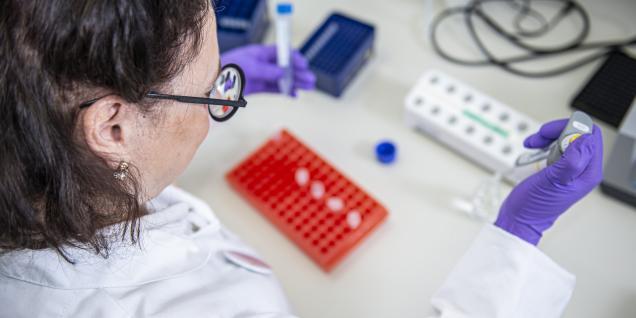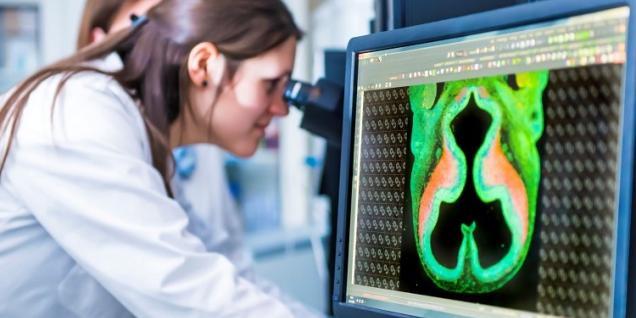Nuclear medicine by MYRRHA
Fighting cancer has never been more urgent
In 2018, an estimated 18.1 million people were diagnosed with cancer, 9.6 million patients died on account of the disease. It is expected that these figures will increase and that, as a result, also the demand for radioisotopes will increase.

MYRRHA as an answer to increasing medical needs
To be able to meet this increasing demand, MYRRHA will take on the production of theranostic radio-isotopes (for diagnostic examinations and therapeutic treatment). With MYRRHA, SCK CEN also focuses on the development of new therapeutic radio-isotopes that can fight cancer cells in a more targeted way and thereby significantly reduce the side effects for patients. As from 2027, the accelerator will produce radio-isotopes for medical purposes.

How about nuclear medicine?
Nuclear medicine uses radioisotopes to diagnose and treat tumours in the human body. Many hospitals use PET (Positron Emission Tomography) and SPECT (Single Photon Emission Computed Tomography) scanners, which routinely make use of radioisotopes to visualise tumours in the body. Prior to such a scan, a solution containing a radioisotope attached to a specific chemical compound is injected into the patient. In the case of molecular imaging or targeted therapy, the chemical compound is selected to target and bind to specific receptors on the tumour cells. From the radiation emitted by a diagnostics isotope, the tumour is visualised through detection of its gamma radiation (photons) leaving the body.
On the other hand, the so-called beta or alpha radiation emitted by a therapy isotope will affect tissue next to the tumour cell (up to a few mm for beta radiation and about 50 µm for alpha radiation). The energy deposited by an alpha particle from such a therapeutic radioisotope is sufficient to kill the malicious cell to which the isotope is attached, while limiting collateral damage to the surrounding healthy tissue. This enables applying such treatment in case of distributed tumours in the body like in metastasis or circulating cancers cells.
Targeted radionuclide therapy is therefore a very promising method for cancer treatment, especially for those cases when classical methods (surgery, external radiation therapy, …) cannot be applied. However, the lack of sustainable radioisotope supplies is currently hindering this treatment to be scaled. Here, MYRRHA will play a major role. The high power of MYRRHA’s proton accelerator and dedicated isotope production programs will allow the supply of these isotopes in large quantities. Moreover, MYRRHA enables the production of different isotopes of the same family (such as various isotopes of terbium) with extremely high isotopic purity. Some of these isotopes have good properties for imaging (gamma and beta emitters), while others are more suitable for treatment (especially alpha, to a lesser degree also beta emitters). When using isotopes from the same family for both therapy and diagnostics (in the “theranostics” approach), the same targeting agent can be linked to each of these isotopes. This enables better assessments of the radiopharmaceutical’s body-intake and of the efficient treatment dose for patients. This is a key element for a successful treatment.
Today, over 10,000 hospitals worldwide use radioisotopes in medicine and about 90% of the procedures are for diagnosis (tumour visualisation). The most common radioisotope used in SPECT imaging, technetium-99 (Tc-99), is formed by the decay of molybdenum-99. More than 30 million procedures are performed with this radioisotope each year, accounting for about 80% of all nuclear medicine procedures worldwide. Currently, the BR2 reactor at SCK CEN is a major player in the global supply of the Tc-99. The MYRRHA reactor will take over this role when it becomes operational.

MYRRHA's ISOL facility produces medical isotopes of high purity
The wide variety of medical radioisotopes for both therapy and imaging are directly accessible at an ISOL facility. Most importantly, an ISOL facility provides a universal means to produce essentially all isotopes of medical interest practically carrier free and of high purity. Consequently, one can enable systematic biokinetic studies, simultaneously with different isotopes and different tracers. Besides the research for new and innovative medical radioisotopes, such isotopes can be systematically produced in very clean conditions with the extended beam times available at ISOL@MYRRHA.
